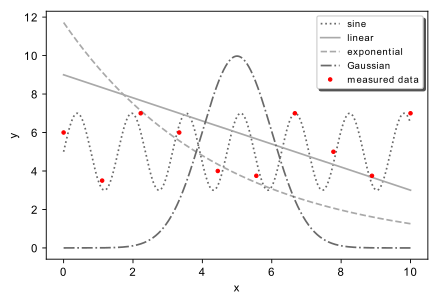URL: https://www.desy.de/school/school_lab/zeuthen_site/cosmic_particles/glossar/@@siteview
Breadcrumb Navigation
Glossar
F
Fit Functions
Often it makes sense to express the measured data as a mathematical function. This modelling of the experimental result allows us to investigate, interpret and describe the correlation between physical quantities. However, we cannot only characterize the actual measured values. A suitable fit function allows us to predict the behaviour of the data beyond our experiment.
The modelling process that includes the determination of the parameters is called fit. Common fit function are linear, exponential, Gaussian and sine or cosine functions.

Forbush Decrease (FD)
 FD is the sudden drop in the measured cosmic radiation intensity. It is characterized by a rapid decrease in the number of measured particles and a return to normal levels over several days (Fig.1-3). These collapses were first described by the American physicist Scott E. Forbush in the 1930s and 1940s.
FD is the sudden drop in the measured cosmic radiation intensity. It is characterized by a rapid decrease in the number of measured particles and a return to normal levels over several days (Fig.1-3). These collapses were first described by the American physicist Scott E. Forbush in the 1930s and 1940s.
FDs are caused by coronal mass ejections. In this process the sun emits large amounts of plasma. The plasma can be imagined as a cloud composed of various charged particles (e.g. ions, protons). As these particles move through space at accelerated speed, they form a magnetic field. The plasma shields other charged particles by its accompanying magnetic field.
 Solar flares are also associated with a shock wave that acts as a particle barrier. Particles are reflected at this shock wave, so that the number of particles behind the shock wave is less than in front of it.
Solar flares are also associated with a shock wave that acts as a particle barrier. Particles are reflected at this shock wave, so that the number of particles behind the shock wave is less than in front of it.
When the shock wave and the plasma hit the earth, a two-stage FD can be observed. The first break-in is caused by the shock wave. Since there are fewer particles behind the shock wave, fewer particles can be measured on Earth when the shock wave hits the Earth. When the plasma reaches the Earth's atmosphere, a second collapse occurs because fewer cosmic particles can reach the Earth's surface again. But this is now caused by the magnetic field of the plasma, which shields the cosmic particles from the Earth. The plasma thus hits the Earth with a time delay and interrupts the return of the rate of cosmic particles to the initial value before the first collapse.
 In general, the rate of cosmic particles is represented as a percentage deviation from an average value. The strength of an FD is expressed as the difference between the particle rate before the event and the rate at the minimum. The website spaceweather provides measurements of FDs since 1957 and can be used to search for FDs. The strength of an FD is given by Dmin and can be found in the table. For the search for FDs in the data of our muon detectors and mini neutron monitors only very strong events should be selected. Events with a value of Dmin<-1.0 are considered to be strong. Examples of FDs measured by neutron monitors can be found on the website of the neutron monitor data base.
In general, the rate of cosmic particles is represented as a percentage deviation from an average value. The strength of an FD is expressed as the difference between the particle rate before the event and the rate at the minimum. The website spaceweather provides measurements of FDs since 1957 and can be used to search for FDs. The strength of an FD is given by Dmin and can be found in the table. For the search for FDs in the data of our muon detectors and mini neutron monitors only very strong events should be selected. Events with a value of Dmin<-1.0 are considered to be strong. Examples of FDs measured by neutron monitors can be found on the website of the neutron monitor data base.
More information about FDs can be found in the Wikipedia article.


